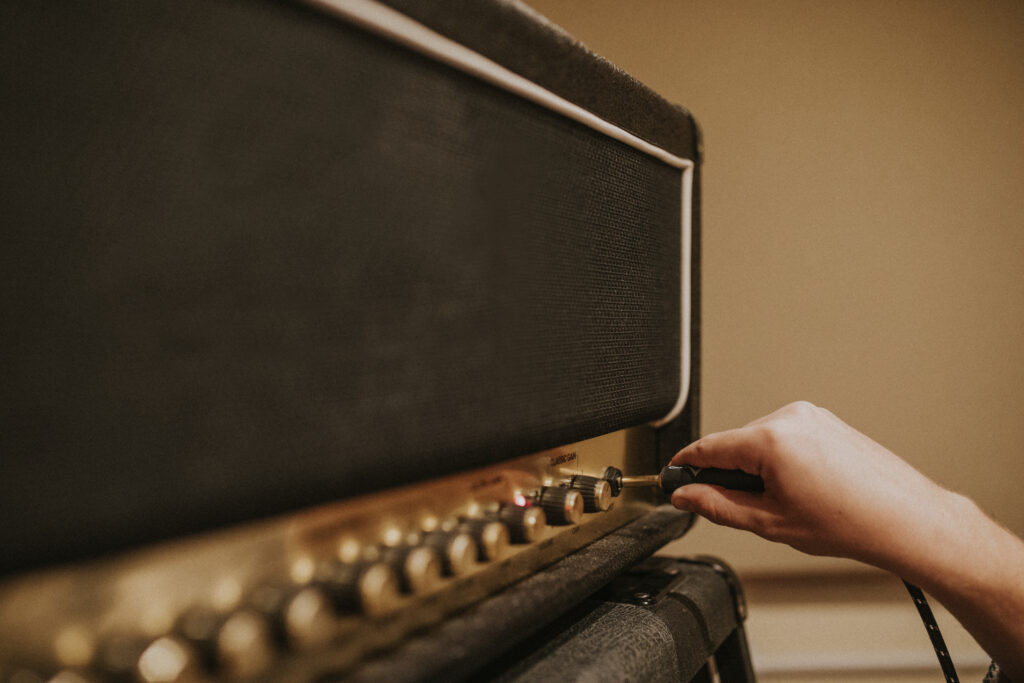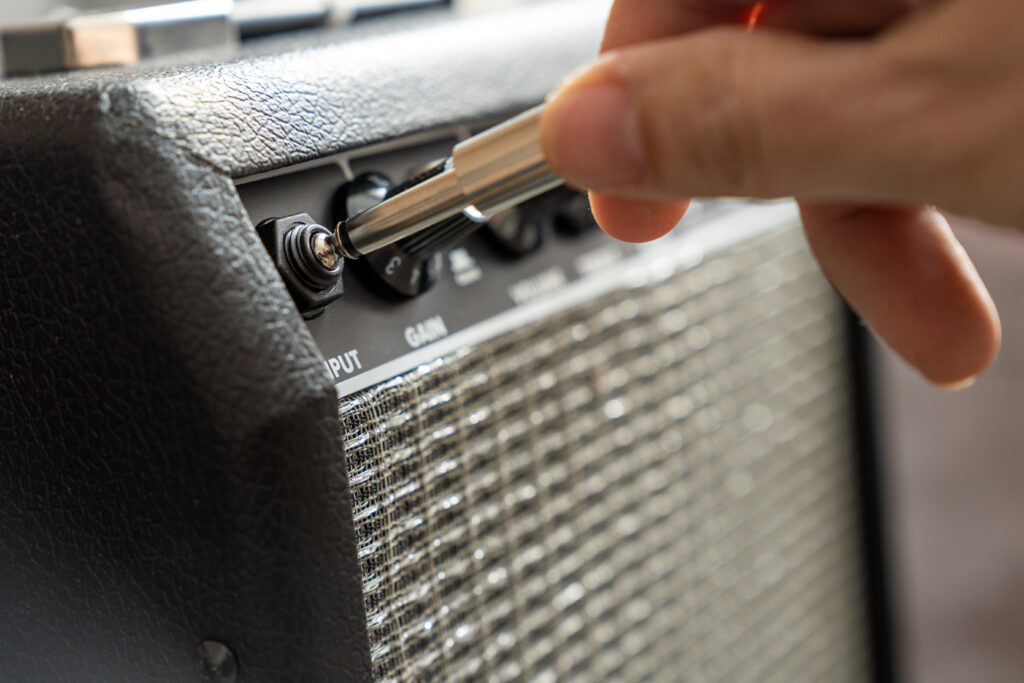
This article “Essential Pointers on Guitars and Amplification” was contributed by guest writer Shawn Leonhardt for Guitar Tricks and 30 Day Singer
The guitar was never that popular in the early 20th century because its volume couldn’t compete with the banjos, drums, and orchestra instruments. By the time the electric guitar was invented, the amplifier allowed the musician to have a much more powerful presence. And ever since the amplifier was created, guitarists have used them to sculpt their sound and cut through the mix.
The First Guitar Amps
An electric guitar does not have anybody for sound waves to reverberate in, so it is necessary to change the vibrations to electrical energy. Early guitar amplifiers were first built in the 1920s and relied on vacuum tubes to amplify the guitar sound. Vacuum tubes were essential in early radar, TV, telephone, and radio technology. They work by heating electrodes in the tube which increases the audio signal.
If you have ever had the chance to play a vacuum tube amplifier it needs to be turned on for a while so it can heat up! These amplifiers weren’t just built for guitars, but the music styles of the time gravitated towards the instrument. Western Swing, lap steel Hawaiian, R&B, and rock revolved around guitars so more engineers built amps specifically for electric guitars, dobro’s, and lap steels.
These early amps were sometimes accidentally or purposely broken or overpowered to create more grit and a rough sound which became known as distortion. Ike Turner, Link Wray, and Dave Davies are some of the more popular artists that purposely used damaged gear to get a raw rock sound. Eventually, engineers began to build these overdrive and distortion functions into the amps and effects units.
As the digital age and transistor technology grew it became possible to build solid-state guitar amps. These were cheaper and more reliable, as vacuum tubes can be fussy and hard to replace. These days solid state amps are more common, but there are still many adherents and fans of old analogue vacuum warmth. Regardless of the guitar amplifier style you prefer, or whether you’re just starting online guitar lessons or are an experienced player, it is important to know how to create your final sound using the parameters you are given.
What Do the Amplifier Knobs and Buttons Do?
One of the first steps is to familiarize yourself with the pickups and knobs on your guitar. Some only have a volume and tone knob, the latter controlling the character and texture of the signal. On acoustic pickups, there are often equalizer controls for the bass and treble, while an electric guitar may have a switch for a clean or crunch-like sound. Some guitarists like to have these knobs all the way up, but it’s probably best to keep it a little below maximum.
Besides your guitar controls, you also want to have a quality cable plugged into your amp. Even if your amp is not super expensive, proper gear is important. You may be plugging your signal into a combo amplifier (one with a speaker), or you may have separate speakers in cabinets (cabs) controlled by an amplifier head. Either way, most amps will have similar knobs and controls.
Power Switch
Before turning this on, make sure your volume and gain are turned down, and keep your guitar away to avoid feedback. If you have a tube amp you will have to wait until the standby switch is ready after turning your amp on.
Volume
The guitar signal travels through a preamplifier that boosts the volume to the level the knob is set at. Without any further tone control of the sound, this will just allow the guitar to be quiet or loud. In some cases, there will be an input volume, master volume, and perhaps volumes for different effects.
Gain
Gain is often confused with volume because it is also increasing the sound. But it is not just amplifying the signal, it distorts it with the overtones that are created with more power to the signal. A blues guitarist would want light gain with a clean overdrive, while a heavy metal player will push the gain into more crunchy territory. Tube amps can use their volume and gain to make even more distorted sounds!
Equalizers
After the signal goes through the pre-amplification stage it is then sent into equalization and tone control. Just like a home or car stereo system, the EQ allows us to adjust the bass, middle, and treble. This doesn’t mean it changes the pitch, it simply highlights or cuts certain frequencies.
Bass
Setting the bass low will give you a thinner sound, turn it up higher will get more boom and low-end sound waves.
Mid
This controls the middle range frequency, which is the most prominent for the guitar. If you have ever heard the term “scooping the mids” it means to turn this button down very low, maybe even to zero. Some metal players like this, while others feel it removes an important aspect of the tone.
Treble
By adjusting the high-end frequency you can turn it up for a bright sound or turn it down for dull. Some amps also have a “presence” knob which usually helps middle and treble frequencies sound livelier. The best way to learn the equalizer is to experiment. Try all combinations and write down what sounds good to you!
Channel Switch
Some amps have a switch for different effects. The most common is a clean vs. crunch tone. However more modern amps also have switches for reverb, delay, echo, chorus and maybe even more. These larger amps with such controls help you sculpt the sound even more without pedals or effects units.

What Settings to Use on a Guitar Amp?
If you happen to be playing a cover or another artist, it is possible to research the exact amp models and settings that they used. In some cases famous guitarists tell fans, and if not there are pages and social media groups dedicated to figuring out guitar amp settings. If you are in a cover band you will want to mimic the tone as closely as you can.
The blues genre tends to stick to tube amps for that warm vibe, while metal tends to stick to solid-state amps for more overdrive control. Country and rockabilly gravitate towards amps that provide chorus and reverb for a twangy feel. And jazz and pop will usually stick with an amp that provides a cleaner sound and less crunch. However there are no absolute rules for which guitars or amps to use, you can be creative with knobs and pedals to produce any sound you want while playing beginner guitar songs or advanced solos.
If you are playing on your own the best way is to experiment with the knobs, just be very mindful of volume and gain levels so you don’t damage equipment or your ears! Don’t just check your tones when playing alone, record on your computer or play with a band to hear how well they mix. A guitar tone at practice time may sound terrible on stage, always check so you don’t realize it too late.
Amp Software
And the best practice is to use guitar amp modelling software. There are interfaces and apps that allow you to plug your guitar into a smartphone, tablet, or computer! You can then try different settings on a variety of modelled equipment. Of course, an old vacuum tube amp sounds warmer and better than an app, but the technology is amazing and allows you to learn the basics of guitar amplification without the huge expense of vintage material!
There are not that many knobs and switches on antique and modern amplifiers. However even with just a few, it is possible to get a variety of guitar textures, tones, and vibes all depending upon the combination you choose. The best way to learn is to plug in your guitar, strum some guitar chords, and simply experiment with different knob settings. Just remember turning it up to the max doesn’t always equal incredible tone!
More Top Tips on our GAK Blog:
Selling Second-Hand Gear FAQ – Your Questions Answered